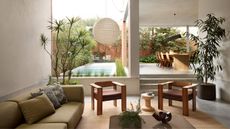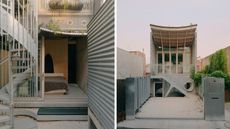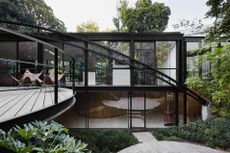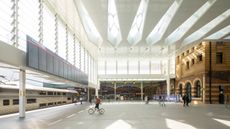South Yarra House makes a sculptural statement in Melbourne
South Yarra House by Pandolfini Architects explores the interplay of compression and expansion through a series of surprising sculptural objects in Australia

South Yarra House by Pandolfini Architects is noticeably restrained and deceptively simple, if you walk past, admiring the eclectic assortment of apartment buildings and Victorian-era homes on this busy street in Melbourne, Australia. But venture behind its bold, seemingly impenetrable gate and a second spirit reveals itself. The home’s full expression encompasses minimalist architecture, robust materiality and a design guided by the interplay between compression and expansion.

South Yarra House: a haven of urban tranquility
To meet the owner’s request for privacy and tranquility, the home reveals little to the passerby beyond its monolithic concrete form, which hovers above the speckled concrete and metallic gate. The architects compare the front façade to a 'blank canvas' onto which the leafy trees lining the street cast ever-changing shadows throughout the day.

Upon passing through the gate, the home’s hidden personality unfolds. Led by Myles Baldwin Design, the landscape design and its dialogue with the architecture are integral to the residence. The home’s heavy concrete form appears airy as it floats above the front garden. A delicate assemblage of Mondrian-like windows etched in reeded glass adds a geometric playfulness hidden from the street.

Inside, the striking double-height foyer is defined by a sinuous concrete staircase, the first in a series of surprising structural forms within. Adjacent to the staircase is the protruding outline of an abstract form clad in clay-toned brick. With their distinct identities, the objects are akin to a series of sculptural pieces on permanent display. Meanwhile, the ground level’s polished concrete flooring is punctuated with large stones, forming a layer the architects describe as a 'metaphorical extension' of the garden.

The expansive foyer transitions into a tunnel-like hallway. Black timber battens line the walls and conceal the doors that open onto the various bedrooms. The effect enhances the feeling of privacy while exploring the dynamic between expansion and compression. Back in the foyer, the staircase ascends towards the kitchen, dining, and living space.

Here, it’s revealed that the abstract brick form is in fact a discreet bar detailed with stone battens, walnut herringbone floors, and aged brass. Yet another sculptural volume demarcates the kitchen, appearing as a zigzagging stone block contrasted by the sleek materiality and curved object edges surrounding it. The main living space opens onto an ample terrace and pool overlooking the garden.

The home sprawls upwards across four floors, condensing its footprint to allow for ample garden space. Materials were selected with consideration for their longevity and minimal maintenance, ‘potentially the most consequential’ choice in terms of sustainable design.
Wallpaper* Newsletter
Receive our daily digest of inspiration, escapism and design stories from around the world direct to your inbox.




Grace Bernard is a freelance writer, editor, and consultant covering design, culture, and travel. In addition to her editorial experience, she has worked as a communications strategist at architecture studios including Walker Warner, Aidlin Darling Design, and SOM.
-
 Three new coffee makers for a contemporary brew, from a casual cup to a full-on branded espresso
Three new coffee makers for a contemporary brew, from a casual cup to a full-on branded espressoThree new coffee makers, from AeroPress, Jura and Porsche x La Marzocco, range from the defiantly manual to the bells and whistles of a traditional countertop espresso machine
By Jonathan Bell Published
-
 Don't miss Luxembourg's retro-futuristic lab pavilion in Venice
Don't miss Luxembourg's retro-futuristic lab pavilion in VeniceAs the Venice Biennale enters its last few weeks, catch 'A Comparative Dialogue Act' at the Luxembourg Pavilion
By Amah-Rose Abrams Published
-
 A Berlin park atop an office building offers a new model of urban landscaping
A Berlin park atop an office building offers a new model of urban landscapingA Berlin park and office space by Grüntuch Ernst Architeken offer a symbiotic relationship between urban design and green living materials
By Michael Webb Published
-
 A Melbourne family home draws on classic modernism to create a pavilion in the landscape
A Melbourne family home draws on classic modernism to create a pavilion in the landscapeThis Melbourne family home by Vibe Design Group was inspired by midcentury design and shaped to be an extension of its verdant site
By Jonathan Bell Published
-
 Tour Clifton House, an airy Bondi family home, brimming with natural light and foliage
Tour Clifton House, an airy Bondi family home, brimming with natural light and foliageClifton House by Anthony Gill Architects is a North Bondi home using an abundance of vegetation to create a slice of privacy within the suburbs
By Tianna Williams Published
-
 Tour this compact Melbourne home, where a small footprint is big on efficiency and experimentation
Tour this compact Melbourne home, where a small footprint is big on efficiency and experimentationNorthcote House is designed by architects David Leggett and Paul Loh as their own home in Melbourne
By Stephen Crafti Published
-
 Bridging Boyd is the rebirth of a modernist Melbourne home
Bridging Boyd is the rebirth of a modernist Melbourne homeBridging Boyd by Jolson is a modernist Melbourne home reimagined for the 21st century
By Ellie Stathaki Published
-
 This Sydney house is a family's stylish seaside sanctuary
This Sydney house is a family's stylish seaside sanctuaryThis Sydney house is a young family's suburban dream come true thanks to Alexandra Kidd Interior Design and Rich Carr Architects
By Léa Teuscher Published
-
 Wallpaper* Architects’ Directory 2024: meet the practices
Wallpaper* Architects’ Directory 2024: meet the practicesIn the Wallpaper* Architects Directory 2024, our latest guide to exciting, emerging practices from around the world, 20 young studios show off their projects and passion
By Ellie Stathaki Published
-
 Peek inside this secluded rural Australian retreat by Alexander Symes, in sync with nature
Peek inside this secluded rural Australian retreat by Alexander Symes, in sync with natureBased in Sydney, Alexander Symes Architect joins the Wallpaper* Architects’ Directory 2024, our annual round-up of exciting emerging architecture studios
By Tianna Williams Published
-
 At the heart of Sydney Metro’s expanded Central Station lies a spectacular new public space
At the heart of Sydney Metro’s expanded Central Station lies a spectacular new public spaceThe new extension to the Sydney Metro, designed by Woods Bagot in collaboration with John McAslan + Partners, can now be accessed beneath its monumental roof structure above the city’s historic Central Station
By Jonathan Bell Published